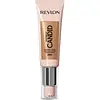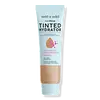Revlon PhotoReady Candid Anti-Pollution Foundation Versus Wet n Wild Barefocus Tinted Hydrator Tinted Skin Veil
What's inside
What's inside
 Key Ingredients
Key Ingredients

 Benefits
Benefits

 Concerns
Concerns

No concerns
 Ingredients Side-by-side
Ingredients Side-by-side

Water
Skin ConditioningCyclopentasiloxane
EmollientDimethicone
EmollientPhenyl Trimethicone
Skin ConditioningPEG-9 Polydimethylsiloxyethyl Dimethicone
EmulsifyingTrimethylsiloxysilicate
EmollientButylene Glycol
HumectantPolymethylsilsesquioxane
Polysilicone-11
Hdi/Trimethylol Hexyllactone Crosspolymer
Aloe Barbadensis Leaf Extract
EmollientAluminum Starch Octenylsuccinate
AbsorbentCamellia Sinensis Leaf Extract
AntimicrobialCucumis Sativus Fruit Extract
EmollientDimethicone/PEG-10/15 Crosspolymer
Disteardimonium Hectorite
StabilisingEthylene Brassylate
MaskingLaureth-7
EmulsifyingLecithin
EmollientMagnesium Sulfate
Maris Sal
Skin ConditioningMethicone
EmollientMica
Cosmetic ColorantPolyglyceryl-3 Diisostearate
EmulsifyingPullulan
Sclerotium Gum
Emulsion StabilisingSilica
AbrasiveSodium Ascorbyl Phosphate
AntioxidantSodium Carrageenan
Emulsion StabilisingTetrasodium EDTA
Tocopherol
AntioxidantTocopheryl Acetate
AntioxidantTriethyl Citrate
MaskingXanthan Gum
EmulsifyingCaprylyl Glycol
EmollientPhenoxyethanol
PreservativeIron Oxides
CI 77891
Cosmetic ColorantWater, Cyclopentasiloxane, Dimethicone, Phenyl Trimethicone, PEG-9 Polydimethylsiloxyethyl Dimethicone, Trimethylsiloxysilicate, Butylene Glycol, Polymethylsilsesquioxane, Polysilicone-11, Hdi/Trimethylol Hexyllactone Crosspolymer, Aloe Barbadensis Leaf Extract, Aluminum Starch Octenylsuccinate, Camellia Sinensis Leaf Extract, Cucumis Sativus Fruit Extract, Dimethicone/PEG-10/15 Crosspolymer, Disteardimonium Hectorite, Ethylene Brassylate, Laureth-7, Lecithin, Magnesium Sulfate, Maris Sal, Methicone, Mica, Polyglyceryl-3 Diisostearate, Pullulan, Sclerotium Gum, Silica, Sodium Ascorbyl Phosphate, Sodium Carrageenan, Tetrasodium EDTA, Tocopherol, Tocopheryl Acetate, Triethyl Citrate, Xanthan Gum, Caprylyl Glycol, Phenoxyethanol, Iron Oxides, CI 77891
Water
Skin ConditioningCyclopentasiloxane
EmollientButylene Glycol
HumectantGlycerin
HumectantDisteardimonium Hectorite
StabilisingCetyl PEG/PPG-10/1 Dimethicone
EmulsifyingLauryl PEG-10 Tris(Trimethylsiloxy)Silylethyl Dimethicone
EmulsifyingPhenoxyethanol
PreservativeMagnesium Sulfate
Triethoxycaprylylsilane
Ethylhexylglycerin
Skin ConditioningDimethicone/Vinyl Dimethicone Crosspolymer
Skin ConditioningSqualane
EmollientSodium Hyaluronate
HumectantHydrolyzed Hyaluronic Acid
HumectantCI 77891
Cosmetic ColorantIron Oxides
CI 77492
Cosmetic ColorantCI 77499
Cosmetic ColorantWater, Cyclopentasiloxane, Butylene Glycol, Glycerin, Disteardimonium Hectorite, Cetyl PEG/PPG-10/1 Dimethicone, Lauryl PEG-10 Tris(Trimethylsiloxy)Silylethyl Dimethicone, Phenoxyethanol, Magnesium Sulfate, Triethoxycaprylylsilane, Ethylhexylglycerin, Dimethicone/Vinyl Dimethicone Crosspolymer, Squalane, Sodium Hyaluronate, Hydrolyzed Hyaluronic Acid, CI 77891, Iron Oxides, CI 77492, CI 77499
 Reviews
Reviews

Ingredients Explained
These ingredients are found in both products.
Ingredients higher up in an ingredient list are typically present in a larger amount.
Butylene Glycol (or BG) is used within cosmetic products for a few different reasons:
Overall, Butylene Glycol is a safe and well-rounded ingredient that works well with other ingredients.
Though this ingredient works well with most skin types, some people with sensitive skin may experience a reaction such as allergic rashes, closed comedones, or itchiness.
Learn more about Butylene GlycolCi 77891 is a white pigment from Titanium dioxide. It is naturally found in minerals such as rutile and ilmenite.
It's main function is to add a white color to cosmetics. It can also be mixed with other colors to create different shades.
Ci 77891 is commonly found in sunscreens due to its ability to block UV rays.
Learn more about CI 77891Cyclopentasiloxane, or D5, is a silicone used to improve texture of products and trap moisture.
D5 is considered lightweight and volatile. Volatile means it evaporates quickly after application. Once evaporated, D5 leaves a thin barrier that helps keep skin hydrated.
It is also an emollient. Emollients help soften the skin and prevent water loss. Silicones create a silky texture in products. D5 helps other ingredients become more spreadable.
Studies show D5 is safe to use in skincare products. We recommend speaking with a skincare professional if you have concerns.
Learn more about CyclopentasiloxaneDisteardimonium Hectorite comes from the clay mineral named hectorite. It is used to add thickness to a product.
It can also help stabilize a product by helping to disperse other ingredients.
Hectorite is a rare, white clay mineral.
Learn more about Disteardimonium HectoriteMagnesium Sulfate is a salt. More specifically, it is an epsom salt, or the bath salt used to help relieve muscle aches.
Despite having ‘sulfate’ in the name, it isn’t a surfactant or cleansing agent like sodium lauryl sulfate. Unlike those sulfates, magnesium sulfate doesn’t have the same cleansing or foaming properties (it's simply a type of salt).
In cosmetics, Magnesium Sulfate is used to thicken a product or help dilute other solids. It is a non-reactive and non-irritating ingredient.
One study shows magnesium deficiency may lead to inflammation of the skin. Applying magnesium topically may help reduce inflammation.
You can find this ingredient in sea water or mineral deposits.
Learn more about Magnesium SulfatePhenoxyethanol is a preservative that has germicide, antimicrobial, and aromatic properties. Studies show that phenoxyethanol can prevent microbial growth. By itself, it has a scent that is similar to that of a rose.
It's often used in formulations along with Caprylyl Glycol to preserve the shelf life of products.
Water. It's the most common cosmetic ingredient of all. You'll usually see it at the top of ingredient lists, meaning that it makes up the largest part of the product.
So why is it so popular? Water most often acts as a solvent - this means that it helps dissolve other ingredients into the formulation.
You'll also recognize water as that liquid we all need to stay alive. If you see this, drink a glass of water. Stay hydrated!
Learn more about WaterThis ingredient is a combination of red, black, and yellow iron oxide pigments. This combination of colors is usually found in foundation, because it results in a "skin" color.